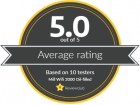Challenger Brands: Part II
How do you spot a challenger brand and what makes them relevant for retailers?
In the first part of our challenger brand series, we presented the challenges that come with working with A-brands and explained why they might not always be the best option for retailers. This time, we want to focus more on challenger brands themselves. What makes a brand a challenger brand, how do you spot challenger brands, and what advantages do retailers have working with these brands?
Let’s start with the definition of a challenger brand. The concept is already 20 years old; in fact, it was first introduced in the 1999 book “Eating the Big Fish,” which became a bestseller and went into a second edition in 2009.
A challenger brand is not necessarily a niche brand. And neither does a challenger brand necessarily challenge another brand. Being a challenger is a mindset more than a market state.
According to www.thechallengerproject.com, which researches challenger brands and their key characteristics globally, “Simply being smaller doesn’t make you a challenger. It’s about a team having ambitions that are bigger than their marketing resources, and challening the codes of the category or the cultural context to create a criteria for choice that favours them, rather than the establishment. Common to many of these challengers is a very simple shift in understanding what a challenger is: not a brand that challenges somebody, but a brand that challenges something; specifically, something they feel needs change.“
In the end, like with many things in life, it comes down to mindset and leadership.
- Challenger brands are led by people with a strong sense of self, able to draw on their passions and authenticity to bring great energy to what they do.
- They’re ambitious and purposeful with a strong sense of direction, concerned not only with what they do for work but why they do it.
- They question things – not simply to agitate but to drive improvement and progress.
- They’re good at inspiring others – bringing colleagues with them through the vision they articulate.
- They find inventive ways to access additional resources, achieving more with less.
- They sustain their tenacity with an optimistic outlook that helps them battle setbacks and rejection.
The book introduces ten challenger credos that stress bringing a fresh perspective to the market, building a prominent and emotionally appealing identity, implementing a pervasive communication strategy and focusing intently on ideas. Challenger brands are not seeking to satisfy everyone but have a very concise and clear point of view. They don’t want to please everyone but they are fully committed to stand by their values and ideas. These strategic core thoughts can take various forms and are summarised in the visuals below:
Whether it’s focusing on a missionary thought with a world view that follows a strong sense of purpose like Tony’s Chocolonely, the German German start-up SHARE, a local hero brand like many microbreweries or an “Enlightened Zagger” deliberately swimming against the prevailing cultural or category tide like the people behind Vitsoe, who truly stand by the Dieter Rams design principles.
Now we know what a challenger brand is, but why should retailers even care? What are the key benefits of working with challenger brands?
Challenger brands have the advantage that they start with a clean slate. One of their key traits is that they not just willing to sacrifice but that – due to limited resources – they must sacrifice certain channels and acitivites to focus on the things that really matter. In our thirty years as a premium value-added distributor, we have learned that challenger brands
- Provide sustainable and attractive growth
- Can be promoted and marketed in a clean and non price-disruptive way
- Make margins that are on average up to 50% higher than on standard A-brands
- Can help increase average selling prices (depending on their role as a challenger)
One note of caution though: Just being new or a start-up does not qualify a brand to be a “challenger” brand. Many companies make the mistake of expecting too high a turnover in the beginning. Yes, true challengers must have high ambitions, but they must also stay realistic and focused.
In order to take on the Goliath or change conventional wisdom in a category, one needs a lot of stamina and the financial resources to enter popular culture and become more widely known amongst consumers.
Furthermore, smart challenger brands take the full margin structure across multiple channels into account from the beginning. Yes, there are brands that build their success exclusively based on a direct-to-consumer model. But even then, these successes are rare and resource-intensive as customers have high expectations in terms of service and shopping experience. Becoming a strong partner with retailers also means providing these retailers with enough room to grow as well as an attractive margin structure.
Mass penetration and a sustainable presence in consumers’ minds can only be achieved with excellent distribution and broad availability. Brands that built their retailer margins into their calculations right from the beginning will have a head start and prevail in the long run.















